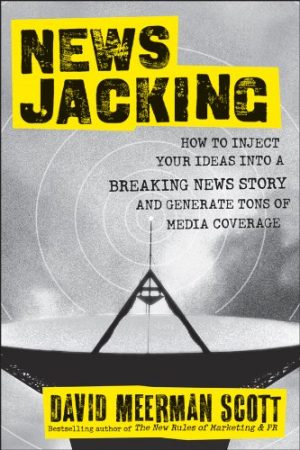Newsjacking: How to Inject your Ideas into a Breaking News Story and Generate Tons of Media Coverage

Any publicity is good publicity isn’t true; however, often, publicity can be good publicity. In Newsjacking: How to Inject your Ideas into a Breaking News Story and Generate Tons of Media Coverage, David Meerman Scott walks you through the process of getting attention you don’t deserve.
Newsjacking
In short, newsjacking is finding a way to insert yourself into a story that isn’t yours – or to amplify your presence in a story that is yours. Newsjacking is about getting attention by being well-placed to take advantage of journalists’ need to cover breaking stories. While Scott doesn’t break things down like this, I tend to think about these in terms of stories and social.
Stories
For some time now, I’ve been receiving notices about journalists who are working on stories and need credible people to quote. Having written a few books and having a few gray hairs makes me more than qualified to be credible in some circles. So, when the topic of burnout is something that journalists need to know more about or quote someone for, I’m happy to jump in. (My wife, Terri, and I published Extinguish Burnout: A Practical Guide to Prevention and Recovery for The Society for Human Resource Management in 2019.)
The good news here is that you can get some good mentions and inbound links. For instance, The New York Times article that quoted me drove about 700 people to the website in the first week. The long-tail impact is hard to measure, since the link immediately increased our Google page rank. The bad news is that there are a lot of pitches you make to journalists that won’t make it. Though Scott didn’t mention it here – or in his last book The New Rules of Marketing and PR – the main source of journalists looking for quotes that I use is Help A Reporter Out (HARO).
These tend – for me – to be less about newsjacking and more about being persistent in sending a message for a long time.
Social
The real key to newsjacking is seeing a trend on social media and grabbing it. Whether it’s a fire and you start offer free fire training or it’s something that you can connect to with a weird angle or connection, finding something on social then becoming a notable bit for the story can be valuable and can land you in the center of the story.
The trick to newsjacking is coming between the breaking story and the scramble for journalists to come up with more about it – including a unique angle. My problem with this is that you’re going to be chasing a lot of stories that look like they might break only to find a small number that actually convert into journalists looking for something new.
Noisy
Another challenge to the approach – for me – is that you must be noisy and available. That means trumpeting your perspective via every channel known to man – even smoke signals and carrier pigeons. For me, that will turn off my regular followers as I bombard them with the kind of things that journalists might find interesting.
It also means making yourself easily available. Demand explains that small barriers stop people in their tracks, and when it comes to a story, something as insignificant as leaving a voice mail may be a major hurdle. The net effect is that you’ve got to be willing and able to answer the phone the moment it rings – without sounding like you’re desperate.
Newsy
For me, the biggest problem is that I’m not very newsy. I don’t read all the sites, watch the latest happenings, or generally get all that concerned about what some star ate five minutes ago and who they were with. That makes Newsjacking a bad fit for me. However, maybe for you, the only thing that separates you from your next stardom is Newsjacking.
